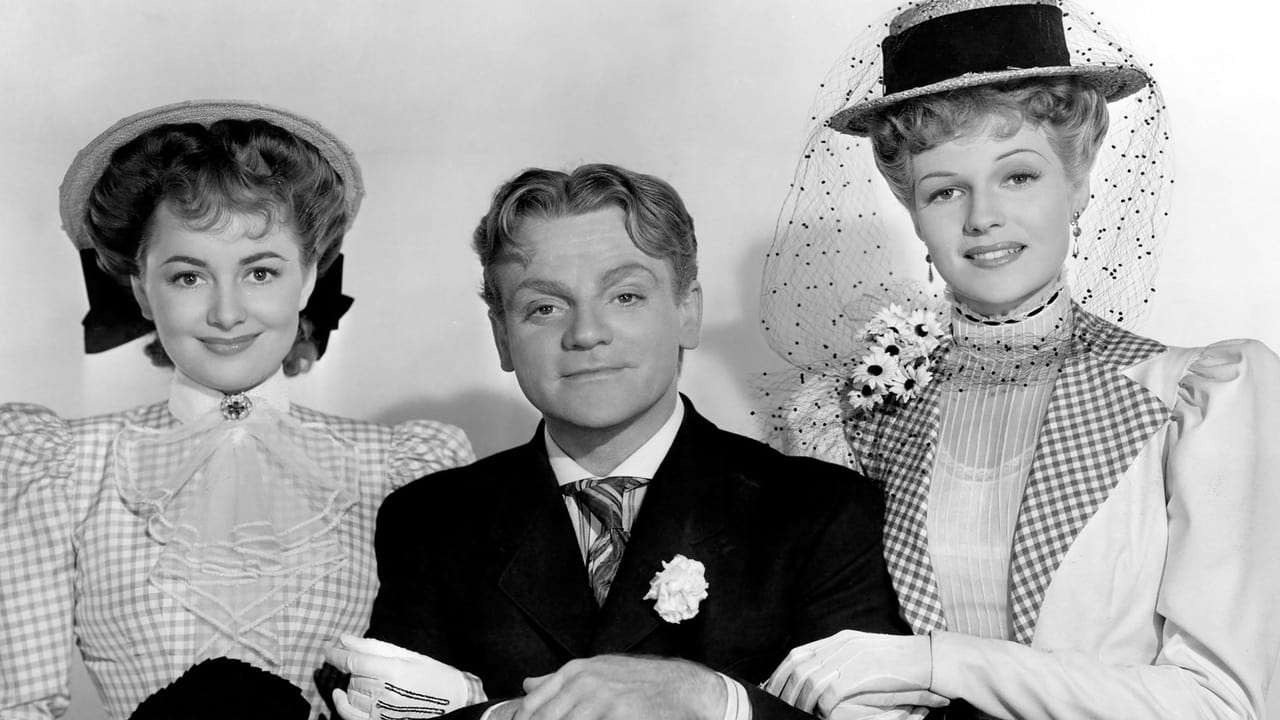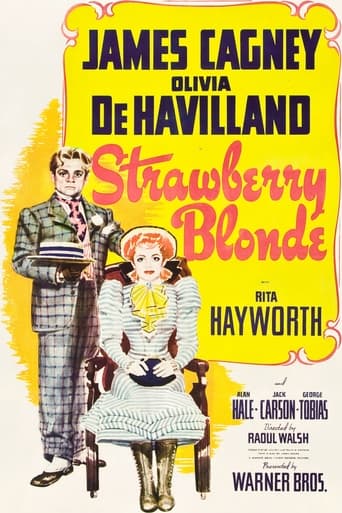

Just perfect...
... View MoreClever, believable, and super fun to watch. It totally has replay value.
... View MoreOne of the worst ways to make a cult movie is to set out to make a cult movie.
... View MoreThis movie feels like it was made purely to piss off people who want good shows
... View MoreWhen you get right down to the message this is really a delightful film. Cagney's character might be brash and a boor at times, but he gets to see the error of his ways after being framed by his boyhood best friend Hugo Barnstead (Jack Carson). The story has a present day (for the turn of the 20th century) opening that flashes back ten years when Biff Grimes (Cagney) and Hugo were beginning to romance the young ladies and about to make their mark on the world.You know, as a time capsule of what life was like a century ago you really can't beat this flick. Biff was learning dentistry by mail order, can you believe that? Why even Doc Holliday went to dental school, so that was an eye opener. Going one better than that though, how about barber Nick (George Tobias) using a leech to treat one of Biff's barroom brawl facial cuts? This wasn't the first time I've seen it in a movie, but it sure does make you wonder what medical procedures must have been like back in the day. Or how a barber could make a living charging twenty cents for a haircut and shave, can you imagine that? Say, what did you think about Amy's (Olivia de Havilland) comment to Virginia (Ava Gardner) when Hugo and Biff showed up the first time - "...come on, let's shake our tootsies"! I'm pretty sure tootsies referred to feet back in the day but watching today it seems like they might have referred to something a bit higher on the anatomy. Considering the era in the story, Amy's views and comments positioned her as a real freethinker, unlike pal Virginia who's comeback was "I refuse to listen to advanced ideas"! She might have had a bit of a problem with Women's Lib in the Sixties, don't you think?Alan Hale was pretty much a sketch in this picture as well, hitting on the neighborhood women and never holding down a job for any length of time. As Biff's Dad, Hale's a riot as a practice patient for one of his son's dental lessons with a little nitrous oxide thrown in for good measure. Watching him here it's hard not to confuse him with his real life son who went on to Gilligan's Island fame as the Skipper. Both had a hearty, jovial nature that their films brought out real well.With it's splendid characters and old time values, this is a treasure of a movie that I'm glad I finally got around to. It's a throw back to a simpler era that can be widely appreciated today when the world seems to be going topsy turvy at times. As the picture's final song suggests, this might be just what you need to 'Let the rest of the world go by' for a couple of hours.
... View MoreThe first time I saw this film, I was so undone by the underhandedness and unfairness, that I swore it off for future viewings. Then it rolled around on TCM's schedule again, and I had forgotten most of the plot. On this viewing, I paid closer attention to every little detail, and I totally changed my mind about this surprising little film. It had little elements of hilarity that I had forgotten or totally missed the first time. Cagney is quite like that in his comedic roles, I've noticed, and De Hvilland is, too.After getting to know James Cagney and Jack Carson a bit better through numerous other films, I began to have a newfound attachment to this film. One main reason is that it just makes better sense when you pay close attention. Once that all happens, you see De Havilland is quite charming and her understated attractiveness totally envelops the cheap tramp ways of the usual bombshell, Rita Hayworth. The only thing that bothers me is the eight years it takes Biff (Cagney) to exact his revenge. Eight years is a long time, but it's a movie and it does fly by! And revenge is exacted. Just as romantic comedies go, there is a very happy ending. The best part is it is totally not formulaic and, therefore, a real surprise. De Havilland and Cagney have one of De Havilland's cutest scenes caught on film as the movie ends. It's a great ending and a surprising little gem made larger and greater by fantastic writing and a superior cast.
... View MoreDuring the golden age of Hollywood, a lot of pictures, especially the romances and musicals, took us back to another golden era – the final years of the 19th century. Not only was this the time in which many of the old guard were in their youth, it happens to be a good era for nostalgia in general. An innocent age before either world war and before the motor car had made the horse obsolete, a world perhaps best summed up by the sweet yet earthy character of its music.The Strawberry Blonde is itself a picture about nostalgia, albeit tinged with regret, as a man goes into a reverie about the friend and the would-be lover who wronged him years earlier. It is no surprise that the screenplay is by the Epstein brothers, Julius and Philip, whose best-known work Casablanca, a story with a very similar mix of regret and fondness for the past. However, with the flashback making up the bulk of its runtime, The Strawberry Blonde is by far the more indulgent of the two. Casablanca lives in the present while The Strawberry Blonde dreams of the past.The director here is Raoul Walsh, who according to the blurb on the back of numerous DVDs was an "action master". A more extensive look at his pictures though reveals him to be a bit of a romantic, with a real feeling for the warmth and intensity of human relationships. Whereas Warner's top director Michael Curtiz always emphasised sets and props, all but burying the actors, Walsh does the complete opposite. Take the scene in the bar where Alan Hale is drinking at the start of the flashback – each shot is made almost entirely of people, with folks lining the edge of the frame. It gives it a real cosy effect. Walsh also places us right inside the emotions of a scene by having actors facing the camera. When James Cagney and Olivia de Havilland are reunited towards the end, the opposing shots of them are not at forty-five degree angles to the lens as convention would dictate. Instead they are virtually looking straight out at the audience.And this is a cast worth focusing on. None of the four principle players – Cagney, de Havilland, Rita Hayworth and Jack Carson – are at their very best, but what's important is that they all seem to be enjoying their roles. Despite being in his 40s at the time, Cagney gives an exuberant portrayal of the younger Biff Grimes, and there is something almost childish in the way he sneers and fidgets his way through his first meeting with de Havilland. De Havilland herself has great fun playing an assertive free-thinker, and while very much against her type she is brilliant at bringing out that saucy flirtatiousness in her character. It's also nice to see Alan Hale playing a more sympathetic variation on his usual reprobate act, far more satisfying than the slightly villainous roles which for reasons I can't fathom he often ended up in. There's also a brief but memorable appearance by the great Una O'Connor.The Strawberry Blonde is by its very nature a movie with a lot of poignancy in it, balanced nicely with its tone of gentle comedy. The only real trouble is that some of the more tender moments are blunted by the punchy pace typical of Warner Brothers pictures, with a few scenes and shots not played out quite as long as they could have been. Still, the picture recovers much of its impact because its emotions are grounded in its atmosphere and its music. While not really a Musical, it is certainly a musical picture with a small "m". Diagetic music (real music in the film's world, as opposed to a background score) plays a major part not just in the story but in the construction of a scene – the strains of a band seeming to regulate or underscore every moment. Even what little non-diagetic music there is seems to dovetail from one of the familiar songs. And in the end, it is that magnificent waltz from which the title is derived that has the final word.
... View MoreCagney departs from his tough, street smart persona to play the gullible, not so tough Biff Grimes. Notice how he loses fight after fight; in one scene he's a barroom bouncer tossing his drunken father out asking his father not to put up too much of a fight "I'm supposed to be a tough guy".He gets suckered time after time by Hugo and Virginia. That wouldn't have happened to other Cagney characters! His best scenes are with Olivia DeHavilland. What chemistry. Sometimes no dialog, just glances.The main characters play off each other phenomenally. Even the minor characters are superb. Who was that fat German who blew beer foam into Cagney's face? He was great! The period music is so woven into the story that the movie almost becomes a musical. The lovely theme that's played whenever Olivia DeHavilland come into the scene is "When You Were Sweet Sixteen". Unlike the title song "Strawberry Blonde", it's never sung in the movie but it was popular at the turn of the century. Perry Como made it one of his hits in the early 1940's.The movie is such a nostalgic, funny, (sad at times) look back at the turn of the century that you wish you could go back there with them.It's amazing that director Raoul Walsh also made the brilliant, violent, cynical "White Heat" with nary a sentimental, lovable character.
... View More